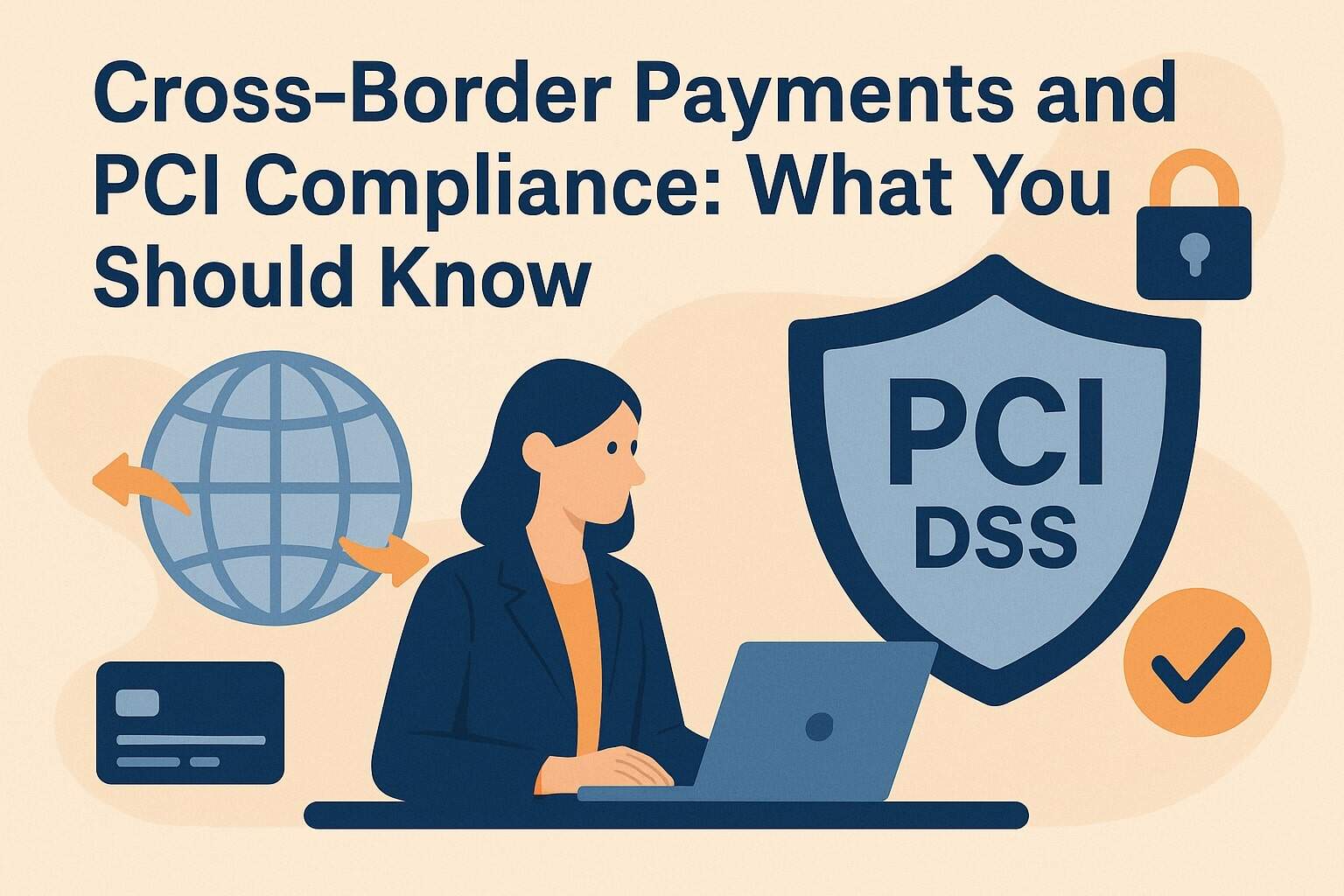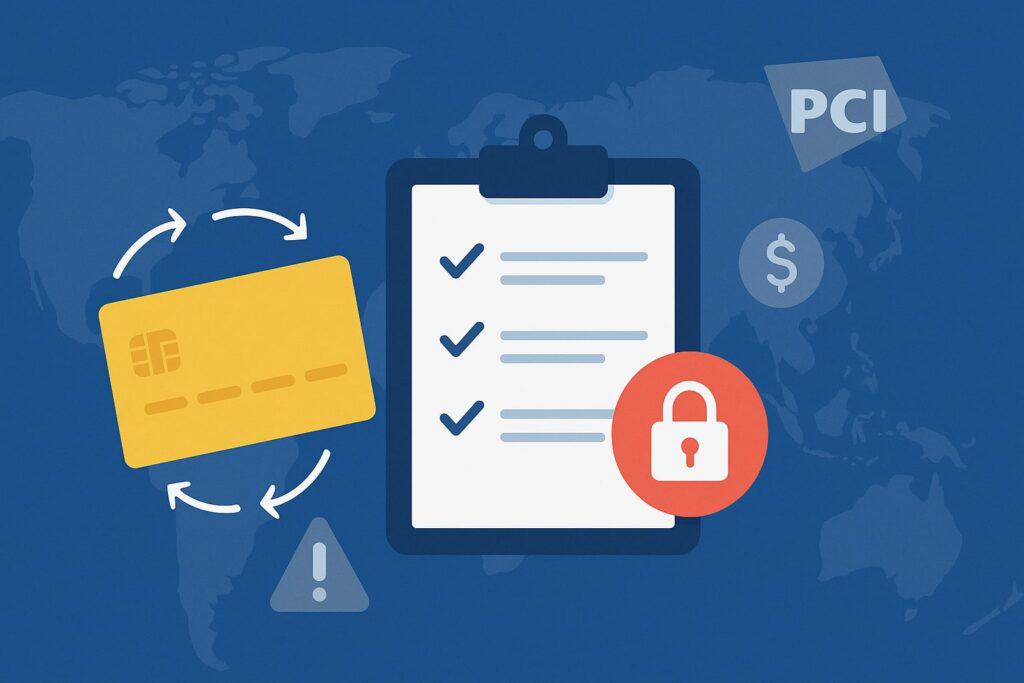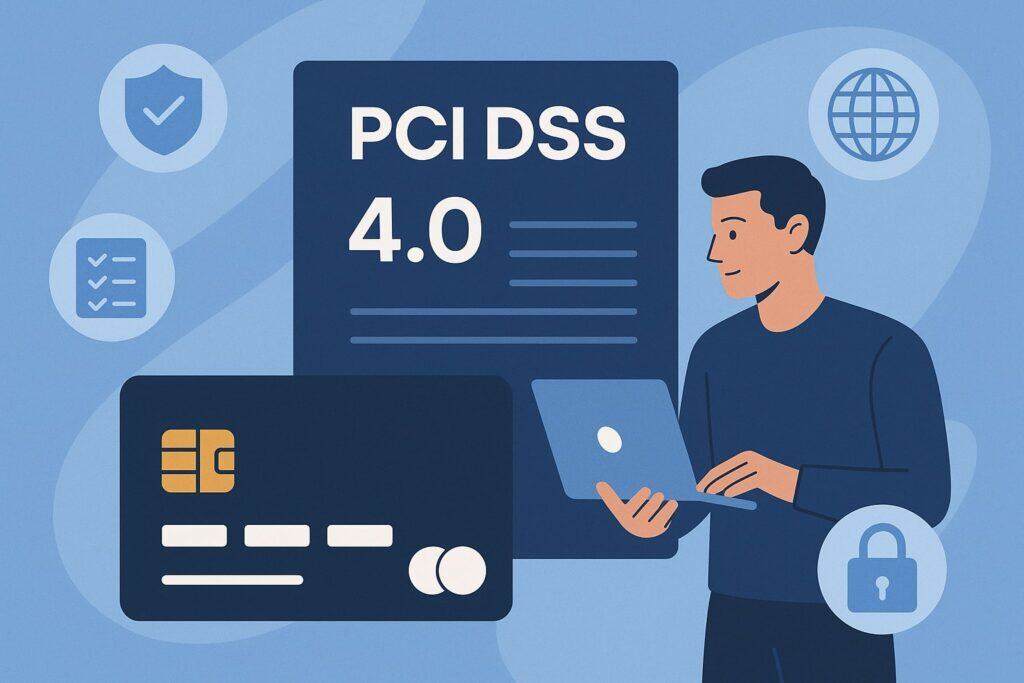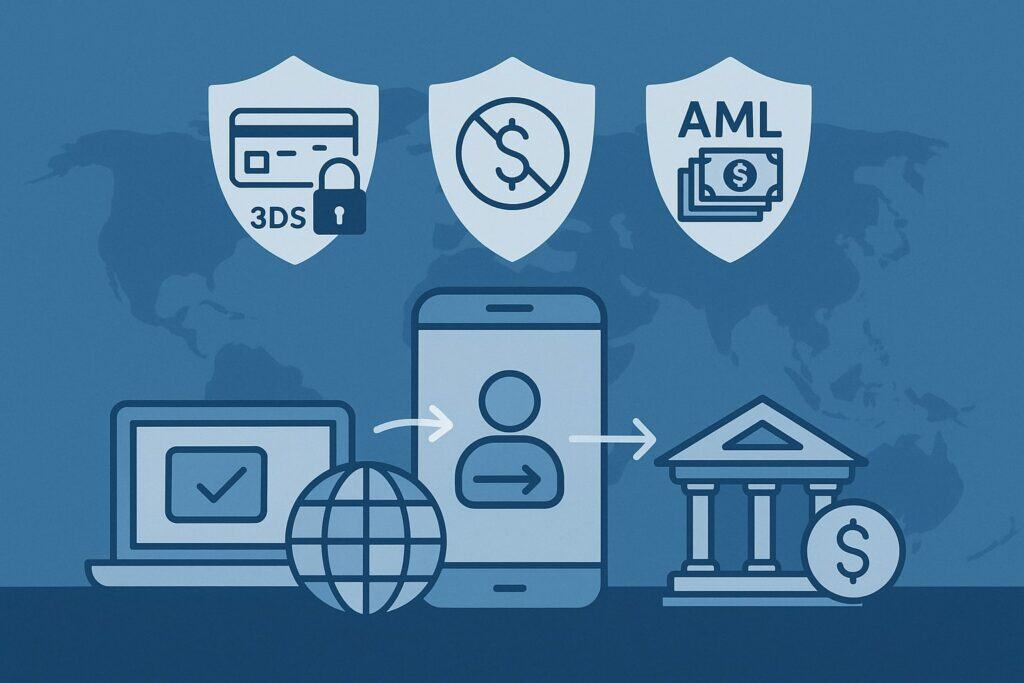
By crossborderfees October 11, 2025
Cross-border payments and PCI compliance are deeply connected. Any business that accepts cards from international customers—whether through an online checkout, marketplace, or global invoice—moves sensitive cardholder data through networks, gateways, processors, and banks that may sit in multiple jurisdictions.
That creates technical, legal, and security complexity that you must manage without adding friction to your customer’s experience. This guide explains how PCI DSS v4.0/4.0.1, sanctions rules, SCA/3-D Secure, ISO 20022 messaging, and forthcoming EU reforms affect cross-border payments and PCI compliance today.
You’ll learn how to scope systems, pick the right SAQ, harden your payment flows, and align with anti-fraud and AML obligations—so cross-border payments and PCI compliance become business enablers, not blockers.
We’ll also translate recent changes into clear actions you can take now to reduce risk, pass assessments, and accelerate international revenue. Throughout, we keep the language practical and the steps concrete, so your team can apply this playbook immediately to cross-border payments and PCI compliance workstreams.
Why Cross-Border Payments Raise the Stakes for PCI Compliance

Cross-border payments and PCI compliance intersect at three layers: the data layer (cardholder data and authentication artifacts), the network layer (how messages traverse providers and countries), and the regulatory layer (which rules apply to each hop).
When you sell globally, more providers touch your card data, more systems cache logs, and more third parties handle fraud screening or tokenization. Each additional participant expands your PCI scope unless you isolate them with well-designed segmentation, tokenization, and managed services.
From a regulatory angle, you must satisfy PCI DSS requirements while also meeting local laws such as EU PSD2 SCA, sanctions screening (e.g., U.S. OFAC’s “50 Percent Rule”), and AML/Travel Rule obligations for certain transfers.
These obligations stack—failing one can impact your entire payment stack, produce settlement delays, trigger chargebacks, or create costly re-underwriting by acquirers.
Technically, cross-border payments often involve currency conversion, regional routing, and message enrichment (for example, risk signals and 3-D Secure data). Those signals are sensitive and must be protected at rest and in transit, with strict key management and access controls.
Finally, operational time zones and language differences can slow incident response and PCI evidence collection. Mature global merchants define clear RACI across providers, maintain evidence in a structured repository, and align controls to “future-dated” requirements in PCI DSS v4.0/4.0.1 that are now in force as of March 31, 2025.
What’s New in PCI DSS v4.0/4.0.1—and Why It Matters for Global Card Acceptance

PCI DSS v4 modernizes the standard with outcome-based flexibility while tightening controls for web payments, authentication, and continuous risk management.
For merchants processing cross-border payments, the most relevant changes include: stronger phishing and MFA expectations, expanded e-commerce script integrity controls (to fight web-skimming), and continuous scoping validation.
These are not optional—future-dated requirements from v4.0 went live March 31, 2025, and v4.0.1 clarifies language without adding new requirements, so you should already be operating to those expectations.
Practically, that means you must inventory all third-party scripts in your checkout, authorize them, ensure tamper detection, and alert on unexpected behavior. You also need robust authentication for administrative access, plus risk-based testing tied to business changes (new PSPs, new markets, or new 3-D Secure flows).
In cross-border contexts, card data may transit multiple countries. v4 emphasizes encryption, key management, access segmentation, and logging that travels with the transaction context.
If you leverage a PCI-compliant payment gateway to tokenize PAN early, your environment can qualify for lighter SAQs—but only if you can prove no sensitive data ever touches your systems. v4 also expects regular scoping reviews; every new global acquirer or local payment method you add can change scope and evidence needs.
A good operating practice is to tie a “PCI scope check” to your global expansion playbook, so each market launch includes a documented delta analysis for affected requirements, SAQs, and compensating controls.
The Regulatory Overlay: SCA/3-D Secure, Sanctions, and AML for Cross-Border Payments

Cross-border payments and PCI compliance do not exist in a vacuum. If you sell into the EEA or U.K., Strong Customer Authentication (SCA) applies under PSD2, typically enforced via 3-D Secure 2 (3DS2).
Issuers can refuse non-compliant transactions, which means your checkout must support frictionless flows where possible and challenge flows when needed.
3DS2 carries device data, risk signals, and authentication results—handled as sensitive data and integrated with your fraud tools. Keeping this integration reliable across countries and BIN ranges is vital for both conversion and security posture.
Sanctions screening is equally non-negotiable. The U.S. Office of Foreign Assets Control (OFAC) administers sanctions programs with strict liability. Its “50 Percent Rule” blocks entities owned, directly or indirectly, 50% or more by one or more sanctioned parties, even if the entity itself is not listed.
For global card acceptance that touches U.S. persons, systems, or currency flows, you must apply risk-based controls to avoid processing prohibited transactions and to respond quickly to potential matches and false positives.
OFAC also encourages innovations for instant payments, but still expects an appropriate, risk-based compliance program with screening, escalation, and recordkeeping.
PCI DSS covers card data security; sanctions controls cover who you can do business with. For cross-border payments and PCI compliance, the two regimes run in parallel and both must be satisfied.
Finally, AML expectations extend to transparency of payer/payee information. The FATF “Travel Rule”—long applied to wire transfers—is now being implemented across virtual asset service providers (VASPs) and increasingly harmonized globally.
Even if you are not a VASP, these trends affect expectations for how you capture, transmit, and protect originator/beneficiary data in cross-border contexts, and how you coordinate with your processors to satisfy regulator requests.
The direction of travel is clear: more structured data, more sharing obligations, and more scrutiny for cross-border payments.
The Messaging Shift You Can’t Ignore: ISO 20022 and SWIFT CBPR+
Behind the scenes, international payments are adopting ISO 20022, a richer and more structured messaging standard. For cross-border card settlements and alternative payment rails, ISO 20022 means more data fields for remittance and compliance, which can improve reconciliation, sanctions screening, and fraud analytics.
SWIFT’s cross-border payments migration (CBPR+) is in a coexistence period—ending November 2025—after which ISO 20022 becomes the global standard for relevant message types.
If your bank or processor is not fully ready, you could see delays or rejections in settlement messages, with knock-on customer support and cash-flow issues.
The key action for merchants isn’t to implement ISO 20022 themselves but to confirm that acquiring banks and PSPs are production-ready, test message flows for your currencies, and ensure your ERP can ingest enriched remittance data.
ISO 20022 also helps with compliance analytics. Structured party fields allow better name screening, address matching, and anomaly detection. This pairs well with PCI DSS logging and monitoring expectations—security analysts can correlate payment events with identity risk signals, device fingerprints, and 3DS2 outcomes.
As your finance and security teams adopt ISO 20022-enabled reports, revisit your PCI evidence checklist to include samples of enriched messages and alerts demonstrating that structured data leads to measurable control effectiveness. That narrative resonates with QSAs and regulators alike.
Practical PCI Scoping for Cross-Border Payment Stacks
Scope everything that can touch Primary Account Number (PAN). Start by mapping every point where PAN or sensitive authentication data could appear: checkout pages, mobile SDKs, payment APIs, third-party scripts, web-application firewalls, CDNs, logging pipelines, and analytics tags.
For cross-border payments and PCI compliance, expand that map to include regional gateways, local acquirers, alternative payment methods that use cards as a funding source, risk engines, and 3DS servers.
Confirm whether each component stores, processes, or transmits card data, and whether tokenization occurs before your systems see it.
If you use a fully outsourced model with client-side tokenization, you may qualify for SAQ A or A-EP; if your servers handle the card data or host payment pages, expect SAQ D. Validate this with your acquiring partners and your QSA—don’t self-declare based on assumptions.
Design for de-scoping at the edges. The fastest way to right-size scope is to adopt P2PE or validated encryption to keep raw PAN out of your network, and to use iFrame or redirect models that isolate card data entry to PCI-certified providers.
For global checkouts, maintain multiple integration patterns: iFrame in high-risk regions, direct-post in markets where you need custom UX and can still keep PAN out of your servers, and native mobile SDKs that tokenize on device.
Align this with 3DS2 so risk and authentication data flow without exposing sensitive elements. Every quarter, run a scoping review that includes your cross-border vendor list, DNS records, and script inventory; attach evidence of changes and outcomes to your PCI repository.
This discipline turns cross-border payments and PCI compliance from a yearly scramble into a steady cadence of risk reduction.
Building a Control Stack That Works Internationally
Authentication, Access, and Administrative Security
For cross-border payments and PCI compliance, administrative access is a common weak point—especially when offshore teams, vendors, and MSSPs need intermittent production access.
Under PCI DSS v4, expect to demonstrate phishing-resistant MFA for admin access where feasible, credential lifecycle management, and monitoring for anomalous access by geography and time. Implement JIT (just-in-time) access with time-bound approvals, enforce least privilege across PSP dashboards, and use hardware-backed MFA for high-risk roles.
When teams in different time zones operate your payment stack, define escalation paths that do not rely on any single country’s business hours. Capture audit trails that show who approved access, from where, for how long, and for which systems.
These access records, along with change tickets, should sit in your PCI evidence bundle to satisfy v4’s focus on continuous control operation.
Web and Mobile Checkout: Script Governance and 3DS2 Resilience
Browser-side security matters more in cross-border scenarios where unfamiliar devices and networks are common. Maintain an allowlist of third-party scripts, enforce Subresource Integrity (SRI) where supported, and use a CSP that blocks unexpected sources.
Instrument real-time alerts when scripts change, domains resolve to new IPs, or a provider adds new code paths. Tie this to a runbook that can disable non-essential scripts without taking your checkout down.
On the authentication side, stabilize 3DS2 with clear fallbacks: retry frictionless when issuer hints allow, gracefully escalate to challenge, and fail over to a second acquirer if BIN-level issues emerge in a region.
Ensure your PSP shares liability shift details and that your data warehouse captures 3DS2 result codes for fraud analytics and dispute defense. These measures directly address v4 e-commerce requirements and EU SCA obligations.
Data Protection, Logging, and Cross-Border Telemetry
Encrypt PAN and tokens in transit and at rest, rotate keys on a defined schedule, and segment vaults from application tiers. For cross-border operations, pay attention to telemetry: logs can leak tokens, PAN fragments, or auth data if not scrubbed.
Standardize redaction in log shippers and SIEM pipelines; assert that no sensitive data is exported to non-compliant regions or unmanaged tools. ISO 20022’s structured messages can be mirrored into your SIEM for better correlation—but do not pull raw card data.
Maintain data-retention policies that respect local data-protection laws while meeting PCI evidence needs. Build dashboards that show control health by region (e.g., MFA success, 3DS2 outcomes, sanctions screening results, and ISO 20022 message validation) to prove continuous control effectiveness to your QSA.
Sanctions and AML Controls That Pair Cleanly with PCI
Sanctions Screening and the OFAC “50 Percent Rule”
Merchants often assume their acquirer handles sanctions. In reality, liability can extend to you when you direct or benefit from prohibited transactions. Implement pre-transaction and settlement-time screening appropriate to your risk, especially for high-risk geographies and industries.
Your policy should define how you handle potential matches, escalate for review, and document decisions. Train support teams to recognize sanctions-related errors and to avoid providing services to blocked persons pending review.
Update your KYC and vendor diligence to capture beneficial ownership where applicable, enabling you to apply the “50 Percent Rule” and block entities owned (directly or indirectly) 50% or more by sanctioned parties—even when they don’t appear on lists.
Align these steps with OFAC’s compliance framework and instant-payments guidance. For cross-border payments and PCI compliance, this alignment reduces false positives while maintaining strict liability readiness.
AML Transparency, the Travel Rule, and Operational Coordination
Even if you are not a VASP, the global push for Travel Rule implementation sets expectations for transparent party information on cross-border transfers. Work with your PSPs to ensure originator/beneficiary data is collected, validated, and transmitted securely, with clear thresholds and exception handling.
Harmonize names, addresses, and identifiers across your checkout, CRM, and settlement systems to reduce false positives during sanctions/AML screening. Build playbooks for regulator requests that specify which system provides evidence, who the owners are in each region, and expected SLAs.
As FATF and national supervisors intensify Travel Rule enforcement in 2025, global merchants that already operate with structured, accurate party data will see fewer delays and investigations—and can prove control effectiveness more easily during PCI assessments.
What EU PSD3/PSR and Global Trends Mean for Your Roadmap
The EU is refreshing its payments framework with PSD3 (a directive) and a new Payment Services Regulation (PSR). As of June 18, 2025, the Council of the EU agreed its position on the package, enabling trilogue negotiations.
While the final text is pending, the direction is clear: stronger fraud controls, better transparency of fees, and clarified roles/responsibilities across the value chain.
Implementation is likely several years out (industry commentary suggests compliance may be required from the second half of 2027 or early 2028), but merchants should plan now. Expect enhanced data-sharing for fraud prevention, more explicit liability allocation, and potential adjustments to SCA exemptions and open-banking interfaces.
For cross-border payments and PCI compliance, that means building flexible architectures: abstracting risk and authentication services, storing consent and exemption evidence cleanly, and keeping your acquirer mix agile so you can adapt as rules converge or diverge across the EEA and U.K.
A Step-By-Step Action Plan to Align Cross-Border Payments and PCI Compliance
Step 1: Map Your Global Payment Data Flows and Scope
Start with a living data-flow diagram that covers every country where you accept cards, each PSP/acquirer, and every system that touches payment data. Mark where PAN is tokenized, where 3DS2 data flows, and where logs or analytics might capture sensitive fields.
Note jurisdictions with data-localization or export restrictions. Tie each component to a PCI requirement and to responsible owners. This “single source of truth” becomes the backbone of your quarterly scope review and your evidence package.
Cross-border payments and PCI compliance become less complex when everyone references the same, current picture of your environment.
Step 2: Harden E-Commerce Entry Points and Script Governance
Implement CSP with strict source controls, use SRI for third-party scripts, and deploy content-security reporting to detect tampering. Add real-time integrity checks to block malicious changes that could skim data in international checkouts.
Validate that your 3DS2 integration can handle issuer quirks, regional routing, and fallback to challenge without timeouts. Document these controls and test results; attach them to your PCI repository.
These concrete measures directly address v4’s web-skimming and authentication focus and reduce fraud in high-risk regions.
Step 3: Upgrade Identity and Access—Everywhere
Roll out phishing-resistant MFA for admin access, adopt just-in-time elevation with session recording, and enforce least privilege across PSP portals, reconciliation tools, and support consoles.
Align password policies and session timeouts to v4 expectations, and build geo/time-based alerts for admin anomalies. Prove these controls work with SIEM dashboards and ticket evidence. This is especially important when your teams and vendors operate across borders and time zones.
Step 4: Sanctions and AML—Integrate, Don’t Bolt On
Work with your banks and PSPs to confirm how party data is screened at authorization and at settlement, and what your responsibilities are for secondary screening. Build an internal sanctions SOP that references OFAC’s “50 Percent Rule,” escalation thresholds, and documentation standards.
For instant or near-real-time flows, use the risk-based approach endorsed by OFAC to balance speed with compliance. Store final decisions with searchable metadata so you can respond to regulator requests quickly.
Step 5: Prepare for ISO 20022 and Demand Proof from Providers
Ask your acquiring partners for written confirmation of ISO 20022 readiness, CBPR+ testing results, and incident SLAs after the November 2025 coexistence end.
Run pilot settlements in each currency corridor you rely on and validate your ERP can ingest enriched remittance fields. Include ISO 20022 fit-for-purpose evidence in your PCI repository to show that structured data strengthens monitoring and reconciliation.
Step 6: Treat PCI Evidence as a Product
Build a curated evidence library with clear naming, timestamps, owners, and renewal dates. Capture quarterly scoping reviews, 3DS2 test matrices, CSP/SRI reports, MFA enforcement exports, sanctions SOPs, and ISO 20022 readiness letters.
During your assessment, this reduces scramble, speeds QSA reviews, and demonstrates a culture of continuous compliance across borders.
Common Pitfalls—and How to Avoid Them
Assuming the acquirer “covers” sanctions and AML for you
Acquirers screen, but liability can still touch the merchant depending on jurisdiction and structure of the transaction. If you trigger, route, or materially benefit from a prohibited transaction, you may be exposed.
Build your own risk-based screening layers and escalation paths. Document how you apply the OFAC “50 Percent Rule,” and keep evidence of decisions. Pair this with PCI logging to show holistic control.
Letting third-party scripts creep into scope
New marketing tags or A/B testing tools frequently appear on checkout pages—sometimes added by non-security teams. Under v4, you must authorize and monitor scripts and detect tampering.
Use CSP, SRI, and change-monitoring to keep checkouts clean across regions. Tie script changes to a formal change-control process and quarterly reviews.
Treating ISO 20022 as “for banks only”
If your providers miss the November 2025 CBPR+ deadline, you will feel the pain via delayed settlements and reconciliation errors. Get ahead with readiness checks and pilots. Build alternate routing plans for key corridors to preserve uptime while providers finalize migrations.
Metrics That Prove Control Effectiveness
To make cross-border payments and PCI compliance tangible, track metrics that tie security to business outcomes:
- Authorization uplift with 3DS2 in EEA vs. non-EEA, segmented by BIN and issuer.
- Script integrity incidents detected and time-to-mitigated.
- Admin access anomalies detected per quarter and mean time to revoke access.
- Sanctions false-positive rate and time-to-decision, with evidence of OFAC rule application.
- ISO 20022 settlement success rate by corridor and reconciliation latency.
These KPIs, combined with quarterly scoping reviews and change-control artifacts, tell a compelling story to QSAs and regulators—that your controls work and improve global payment performance.
Frequently Asked Questions (FAQs)
Q.1: Do I still need PCI DSS if my payment gateway is “level 1 PCI compliant” and I only sell online to international customers?
Answer: Yes. Using a PCI-certified gateway reduces your scope but does not eliminate it. You must validate that your integration method (for example, iFrame/hosted fields vs. direct API) prevents your systems from storing, processing, or transmitting PAN or sensitive authentication data.
If you never touch card data and strictly use hosted fields or redirects, you may qualify for a lighter SAQ (such as SAQ A or A-EP). But you still need to prove secure checkout pages, script governance, segmentation, logging, and incident response.
International sales add complexity: you may add acquirers for local routing, implement 3DS2 for EU SCA, or add currency conversion—all of which can affect scope. Always align with PCI DSS v4.0/4.0.1 expectations and keep quarterly scope reviews, especially when expanding into new markets.
Q.2: How do EU SCA and 3-D Secure 2 affect cross-border authorization rates and my PCI posture?
Answer: SCA is mandatory for many EEA transactions, enforced largely via 3DS2. Done well, 3DS2 can improve approvals because issuers receive more risk signals and can shift liability. Done poorly, it adds friction and abandonment.
From a PCI perspective, 3DS2 introduces additional data elements and authentication artifacts that must be protected and logged appropriately. You should support both frictionless and step-up challenges, manage exemptions where allowed, and work with acquirers that optimize routing per BIN/region.
Test regularly with EU cards to ensure resiliency as issuer policies change. Keep architectural diagrams and test results in your PCI evidence library to show that authentication is secure and reliable across borders.
Q.3: What is the ISO 20022 deadline and does it change what I must do as a merchant?
Answer: For cross-border payments on SWIFT, the coexistence phase ends in November 2025; ISO 20022 becomes the standard for relevant message types (CBPR+). Merchants typically rely on banks and PSPs to implement, but you will feel the impact through richer payment data and potential settlement changes.
Your action items: confirm provider readiness, test settlement flows in your major corridors, and ensure your ERP and reconciliation tools can consume enriched remittance fields.
ISO 20022 can strengthen sanctions and AML screening by improving data structure, which in turn helps you demonstrate effective monitoring in your PCI program. The key risk is provider non-readiness, which could degrade settlement reliability. Ask for concrete readiness attestations now.
Conclusion
Cross-border payments and PCI compliance are not just boxes to check; they are competitive differentiators. By embracing PCI DSS v4.0/4.0.1’s focus on continuous security, aligning SCA/3DS2 for smoother EU approvals, implementing sanctions and AML controls that actually scale, and preparing for ISO 20022’s richer data model, you build a safer, faster global checkout.
The pieces reinforce one another: PCI logging enhances sanctions investigations, ISO 20022 improves screening quality, and 3DS2 reduces fraud while protecting cardholder data.
Start with a clear data-flow map, reduce scope with tokenization and validated providers, harden your browser side, and prove readiness with a living evidence library.
Do this, and cross-border payments and PCI compliance become the engine that powers reliable international growth—letting your brand enter new markets with confidence while keeping regulators, issuers, and customers on your side.